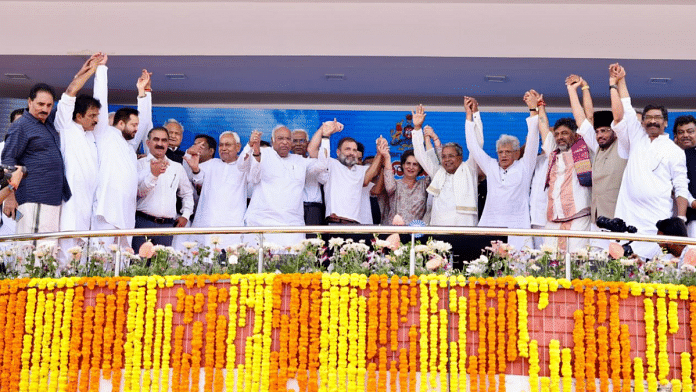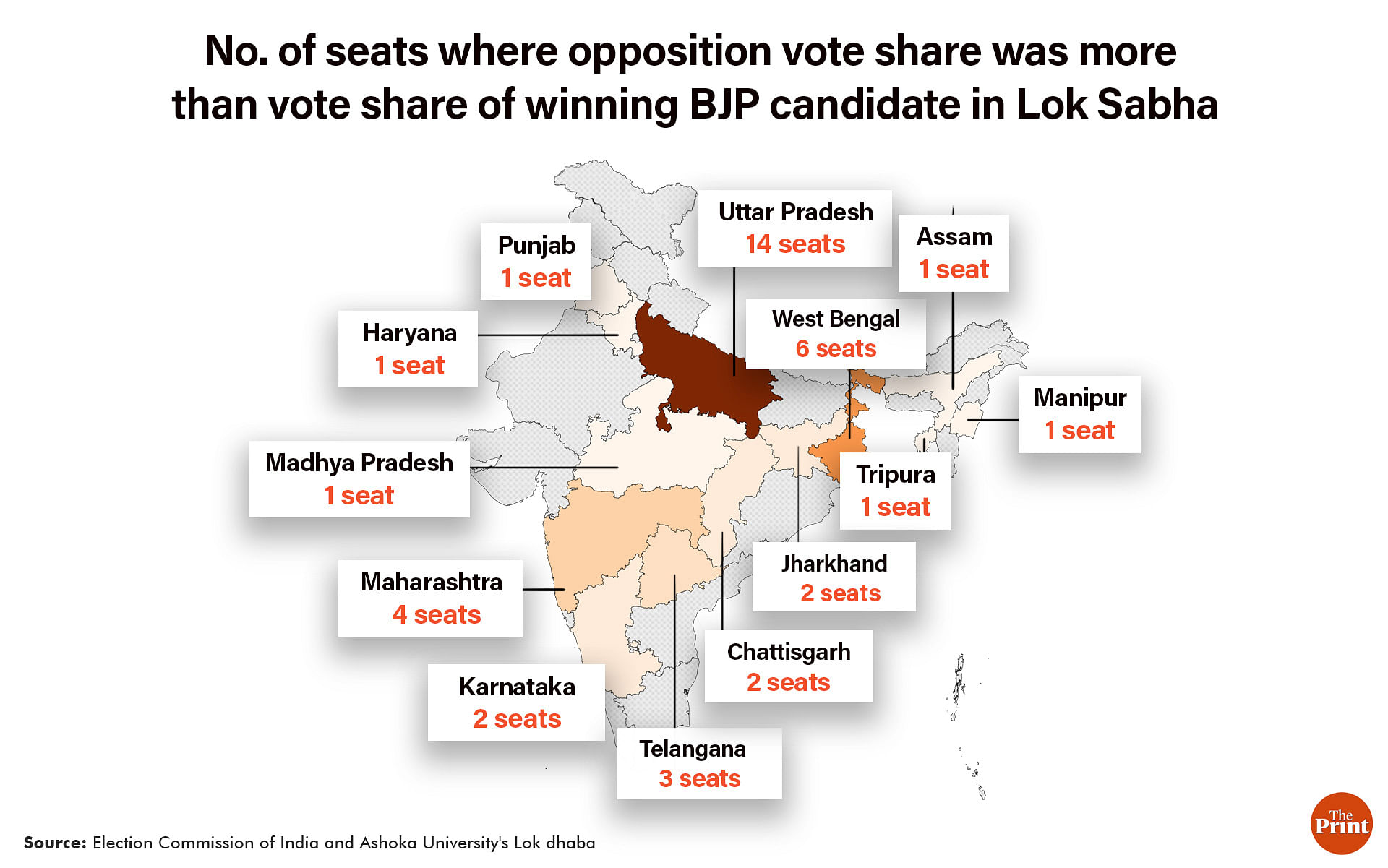
New Delhi: In a show of opposition strength ahead of the 2024 Lok Sabha election, the leaders of 17 non-BJP parties reached Bengaluru Saturday to attend the swearing-in ceremony of Congress leader Siddaramaiah as the Karnataka chief minister.
But, the gathering also exposed the chinks in the opposition camp. The Congress didn’t invite Delhi CM Arvind Kejriwal, his Telangana counterpart K. Chandrasekhar Rao and Bahujan Samaj Party (BSP) chief Mayawati. West Bengal chief minister Mamata Banerjee skipped the ceremony and instead sent TMC MP Kakoli Ghosh Dastidar. Samajwadi Party (SP) chief Akhilesh Yadav also gave it a miss.
Notwithstanding the absence of some heavyweights, the efforts for opposition unity are likely to continue with the next destination being Patna where Bihar Chief Minister and Janata Dal (United) president Nitish Kumar is expected to hold a meeting of opposition leaders.
While it is too early to predict the contours of the opposition alliance for the 2024 parliamentary election, ThePrint analysed the 2019 Lok Sabha election numbers to see if the opposition was united then, how it would have affected the BJP’s score of 303 seats.
ThePrint checked data from these 303 seats and compared the BJP’s vote share with the sum total of votes received by major anti-BJP opposition parties.
Major parties accounted for in the calculation include the Congress, the BSP, the SP, the Trinamool Congress (TMC), the All India United Democratic Front (AIUDF), the Left parties (except in Bengal where they are unlikely to go with Mamata), Janata Dal (Secular), the Aam Aadmi Party (AAP) and the Bharat Rashtra Samithi (BRS), among others.
The AAP and the BRS — Congress’ arch-rivals in Delhi and Telangana — were selected as they attended the Congress-led opposition meetings in the last session of Parliament. The Biju Janata Dal (BJD) was left out as it is likely to go alone in Odisha.
Some of the prominent smaller parties considered for this report include Prakash Ambedkar’s Vanchit Bahujan Aghadi, Shivpal Yadav’s Pragatisheel Samajwadi Party (Lohiya), Raghuraj Pratap Singh’s Jansatta Dal (Loktantrik) and O.P. Rajbhar’s Suheldev Bhartiya Samaj Party. Together, these parties along with other major opposition rivals received more votes in as many as 39 seats that were won by the BJP.
A closer look at the data will be a dampener for those calling for a rainbow alliance of the Congress and the regional parties in the run up to the 2024 general election.
For instance, the BSP was factored in even as it had an alliance with the SP and the Rashtriya Lok Dal (RLD) in Uttar Pradesh, without the Congress party. If the Congress was part of that alliance, the BJP’s tally would have come down by 14 seats — reducing it to 42 in the state that sends 80 members to the Lok Sabha.
Besides, if the BSP and the Congress had allied in Chhattisgarh, Jharkhand, Haryana, Karnataka, Madhya Pradesh and Punjab, the BJP would lose eight more seats. So, in 2019, the BSP alone would have reduced the BJP’s overall pan-India tally by 22 seats. However, BSP supremo Mayawati has already declared that her party will not go for any alliance in 2024.
Though the SP-BSP-RLD won 15 seats, one doesn’t know how this alliance would have done if Mayawati had gone alone. It can, however, be argued that the BSP is a much diminished political entity in the last few years.
Similarly, the Congress and the TRS together in 2019 would have reduced the BJP’s tally from 4 to 1 in Telangana. It’s again an unlikely scenario, given that they remain arch rivals despite the BJP emerging as the principal challenger in this year’s assembly polls.
Another such state is West Bengal where an understanding between the Congress and Mamata, leaving out the Left parties, would have cut down the BJP’s tally from 18 to 12.
An AIUDF-Congress understanding like in the 2021 state election would have resulted in the BJP losing Karimganj seat in Assam. In Manipur and Tripura, an alliance of the Congress, the Left parties and the Amra Bangali, could have resulted in two seats — Inner Manipur and Tripura East — in the opposition kitty.

More importantly, the so-called opposition unity — even at a scale that looks so unlikely — wouldn’t have been able to deny a second term to Prime Minister Narendra Modi as the BJP’s overall tally would go down by 39 seats to 264 seats, only eight short of majority.
This analysis cannot be taken as an indicator of 2024, of course. People’s voting preferences may not be the same as they were in 2019. Moreover, general and state elections are separate electoral challenges.
Equations have also changed in many states, including Maharashtra where the Maha Vikas Aghadi alliance looks formidable and in Bihar where Nitish Kumar-led alliance seems to be equally strong. The BJP has also lost many allies, especially after 2018 such as the Shiromani Akali Dal, the Shiv Sena and the Telugu Desam Party.
Also Read: Why BJP has much to look forward to in 2024, despite Karnataka assembly election loss
Will opposition unity impact 2024 election?
After the Congress’ resounding win in Karnataka, TMC chief Mamata Banerjee called for the Congress to let strong regional players fight in their respective states.
“Wherever a regional party is very strong….the strong party must be given priority. Wherever Congress is strong in their respective 200 seats or something. Let them fight, we will give support. Nothing is wrong (in that). But they (Congress) have to support the other political parties also,” she has said.
However, Congress MP from Bengal, Adhir Ranjan Chowdhury refuted it saying that the party “will continue to fight against the TMC” in the state.
Despite the Karnataka election result, a political analyst believes that the opposition unity is still far off.
“While the desire for opposition unity has gone up, the bottleneck for the opposition unity has become much more firm. Now the Congress is getting a sense that there is a mood in its favour after the success in Karnataka. So, the Congress will not be ready to concede (in terms of seat sharing) as much as it might have been willing to earlier,” Sanjay Kumar, co-director of Lokniti, a research programme at the Centre for the Study of Developing Societies (CSDS), told ThePrint.
In case the opposition parties come together, Kumar said, they will be able to challenge the BJP “more firmly”. “But does that mean they will be able to defeat BJP? I am not sure.”
According to the political analyst, BJP still may emerge as the single largest party and the gap between number one and two would still be very large.
“I don’t see the BJP tally going below 200 or 210 even if all opposition parties come together. I am saying this because there is also a possibility of counter polarisation. Secondly, if these parties come together, a majority of their voters will vote for each other but it is not a 10 per cent vote transfer. Generally, we expect 60-70 per cent votes to transfer in such a scenario,” the CSDS co-director said.
BJP national spokesperson Gopal Krishna Agarwal said that on the ground, things are not maturing for opposition unity. “There are so many differences in opposition, especially in terms of ideology. It is very difficult to implement,” he said. “How will votes transfer? Votes are not in their pockets. The SP-BSP tried this arrangement, but their votes were not transferred. Transferring votes is not easy.”
“We fight every election with full force. We take it (united opposition) as a challenge as well out of many other challenges,” Agarwal said to a query on whether the BJP is at any risk, from a united opposition.
He added that the BJP is working to target 50 per cent vote share, so a united opposition would not impact its fortune.
(Edited by Tony Rai)
Also Read: Yoga, swacchata, Bapu, but very little Nehru — decoding 99 episodes of Modi’s Mann ki Baat

COMMENTS